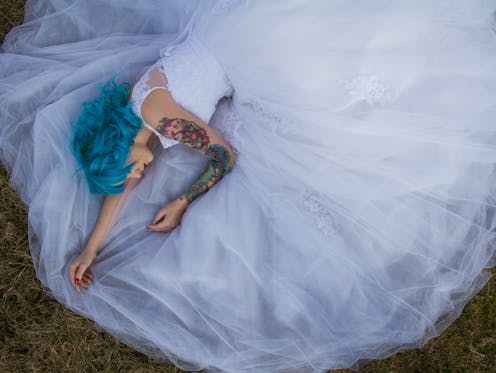Is marriage modern? Anna Kate Blair's novel poses the question, but doesn't answer it
- Written by Edwina Preston, PhD Candidate, The University of Melbourne

Is marriage modern? This is the circuitous premise of Australian writer Anna Kate Blair’s debut novel, The Modern, set in contemporary New York and centred on the life, half-loves and near-loves of Sophia, an Australian research fellow at MoMA (the Museum of Modern Art).
Sophia’s fellowship at MoMA is coming to an end. About to turn 30, she is facing future job precarity. In this transitional state, she becomes engaged to her longtime boyfriend, Robert – an academic and avid hiker, who plops a marriage proposal onto her lap, then embarks on a five-month trek through the Appalachian Mountains.
Review: The Modern – Anna Kate Blair (Scribner)
Sophia’s engagement shakes out a constellation of loose questions about potential choices, possibilities and limitations. Her relationships have previously been with women, her queerness suppressed in a longstanding heterosexual relationship that is easy and affirming, but ultimately, the reader feels, taken for granted – not so much by Robert as by Sophia herself.
When Robert departs, Sophia meets the mercurial, filament-like Cara, an unlikely assistant in a little-frequented New York wedding boutique. In her spare time, Cara makes art using photographed wedding-dress remnants. Sophia falls for her. Cara does not reciprocate.
Is marriage modern?
The question “Is marriage modern?” is less the fulcrum of Sophia’s personal narrative than, increasingly, a perplexing nonsense rhyme, or rhetorical question weighed down by its own glowering question mark.
Is marriage modern? Are clothes modern? Sophia asks. Are houses modern? Children modern? Rats modern?
The question feels decidedly oxymoronic. In the context of same-sex marriage, which Blair touches upon, marriage is modern, so long as you don’t drill down to its ideological underpinnings: the history of marriage as property transfer, its requisite reproductive labour, the spectacle of grim-lipped, decades-long resentments sustained under the oath of “til death do us part”.
By what barometer might we gauge “modernity” in marriage? Happiness? Unhappiness? Equality? Freedom to realise the self within the safety of mutuality?
Or is it all, in the end, about the dress?
Smacked in the face by a dress
Like Sophia, the idea of marriage has always repelled me, but then (also like Sophia) one day I found myself hit by a dress. Smacked in the face by it. A flounce-ridden, gorgeously deep-red wedding dress in a Moonee Ponds wedding boutique window.
For one second, I entertained the idea of a wedding, but only because of that dress. Sophia has similar swooning moments imagining, choosing, thinking about the dress.
She goes dress-shopping with her overly conscientious mother-in-law-to-be; she considers the instances of wedding dresses in art and the emblematic 1954 painting Grand Street Brides by abstract expressionist painter Grace Hartigan: six ghoulishly clad brides outside a wedding shop, a shimmer of white and crimson and green that bodes ill as much as good.
Grace Hartigan’s six ghoulishly clad brides bode ‘ill as much as good’.But the phenomenon itself – the overweening presence of the wedding dress in young women’s lives – remains under-explored. Sophia is constantly taking photographs and uploading them to Instagram, but her conjuring of ideas feels like a once-posted, easily forgotten exercise.
It’s as though simply posing questions and thrusting them out into cyberspace is sufficient: the archival evidence of having had a thought or idea about something precluding the need to explore that idea further.
Modern art ‘at every turn’
If the novel’s central question is not answered or adequately dissected, questions of modernity in art are more fulsomely, if curatorially, examined. The Modern tosses “modern” artists and art at the reader at every turn, assuming a familiarity with art history on the reader’s part.
This is not a bad thing, of course, but I was glad to have seen photographer Nan Goldin’s 1980s New York exhibition, The Ballad of Sexual Dependency, at the National Gallery of Australia recently. It gave me a touchstone for Sophia’s descriptions of these tender, bruising countercultural images. Other works, other artists, skated past me without feeling synchronous with the narrative, or like they expanded it.
Nan Goldin on The Ballad of Sexual Dependency.The Modern overflows with ideas: musings on modern art, and on the masculinist orientation of art institutions, in which female curatorial assistants doggedly do the work their male supervisors put their names to.
And musings on the nature of marriage as a “ceremony that [sits] awkwardly between the libidinal and the legal” – a ceremony to which Sophia is curiously drawn, in spite of her rational instinct to repudiate it.
Sophia’s relentlessly self-reflecting narrative is shot through with titbits from the life of Grace Hartigan, her dissertation subject. Grand Street Brides functions as an almost-motif throughout the novel, its Picasso-esque, post-cubist awkwardness reflecting Sophia’s own ambivalence about marriage.
Sophia’s curatorial instinct cannot help but see weddings as “huge installations with a performance element”, the wedding dress as a shimmering fabric monument (to be later dyed black and re-used).
Curated, rather than known
The Modern charts Hartigan’s life – three marriages, three significant relationships, an important friendship with curator and poet Frank O’Hara (champion of Jackson Pollock) – but she remains an under-exploited (or perhaps I should say under-illuminated) throughline in the novel. She is curated rather than known; she’s a collection of iterations.
Perhaps this is Blair’s intention: Hartigan as surface, knowable only through her work, her private self inured to the public gaze. But every character in The Modern feels somewhat like a bit-part: fleeting, insubstantial, or, in Robert’s case, downright wooden.




